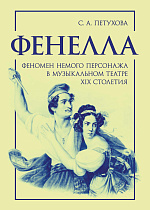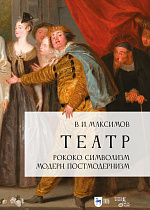История зарубежного театра - все книги по дисциплине. Издательство Лань
Сохранить список:
Excel
Excel
Закрыть
Выгрузка списка книг доступна только авторизованным пользователям. Авторизоваться
Настоящая книга является первой попыткой рассмотрения феномена немого персонажа в оперном театре романтического XIX века. Главное место в исследовании занимает образ Фенеллы — титульной роли в опере Даниэля Обера и Эжена Скриба «Немая из Портичи» (1828), созданной для пантомимной солистки. Некогда это сочинение имело фантастическую популярность, а безмолвная партия становилась предметом конкуренции артисток разного амплуа: балерин и мимисток, драматических актрис и певиц. История постановок оперы на Западе и в России базируется на подробностях биографий этих исполнительниц, их взаимоотношений, пристрастий и интерпретаций.
Книга снабжена иллюстрациями и развёрнутыми приложениями, помогающими ориентироваться в театральном мире ушедших времён. Издание предназначено для специалистов театра и музыки, а также для всех, кто любит балетное искусство.
The current book is the first attempt to study the phenomenon of a mute character in the romantic 19th century opera theatre. The main place in the study belongs to the Fenella image, the title role in “La Muette de Portici” (“The Mute Girl of Portici”, 1828), the opera by Daniel Auber and Eugène Scribe, created for a solo pantomime performer. The piece used to be incredibly popular, and the mute part became the subject of competition between artists of a different type: ballet dancers and mime artists, drama actresses and singers. The history of the opera’s productions in the West and in Russia is based on these performers’ biographical moments, their relationships, sympathies and interpretations.
The book is illustrated and provided with detailed appendices, aimed to help readers understand the theatrical world of bygone times. The edition is intended for theatre and music experts, as well as for all music theatre lovers.
Книга снабжена иллюстрациями и развёрнутыми приложениями, помогающими ориентироваться в театральном мире ушедших времён. Издание предназначено для специалистов театра и музыки, а также для всех, кто любит балетное искусство.
The current book is the first attempt to study the phenomenon of a mute character in the romantic 19th century opera theatre. The main place in the study belongs to the Fenella image, the title role in “La Muette de Portici” (“The Mute Girl of Portici”, 1828), the opera by Daniel Auber and Eugène Scribe, created for a solo pantomime performer. The piece used to be incredibly popular, and the mute part became the subject of competition between artists of a different type: ballet dancers and mime artists, drama actresses and singers. The history of the opera’s productions in the West and in Russia is based on these performers’ biographical moments, their relationships, sympathies and interpretations.
The book is illustrated and provided with detailed appendices, aimed to help readers understand the theatrical world of bygone times. The edition is intended for theatre and music experts, as well as for all music theatre lovers.
В настоящее издание, помимо исследования доктора искусствоведения, профессора В. И. Максимова о театре и драматургии французского и русского символизма, включены пьесы Мориса Метерлинка в переводе Константина Бальмонта, пьесы Поля Верлена и других символистов, знаменитая трилогия о Папаше Убю Альфреда Жарри. Среди теоретических статей и материалов литераторов и театральных деятелей особо выделяются главы из четырехтомных мемуаров одного из самых значительных французских режиссеров первой половины ХХ века О. М. Люнье-По "Парад". Книга представляет несомненный интерес для литературоведов, театроведов, историков искусства, театральных практиков, почитателей французской культуры.
In addition to the study on the theatre and dramaturgy of French and Russian symbolism written by the doctor of art history, professor V.I. Maksimov, the current edition includes the plays by Maurice Maeterlinck translated by Konstantin Balmont, the plays by Paul Verlaine and other symbolists, the famous trilogy about Père Ubu by Alfred Jarry. Among the theoretical articles and materials of writers and theatre figures, the chapters from the “La Parade” (“The Parade”) stand out, the four-volume memoirs by A. M. Lugné-Poё, one of the most significant French directors of the first half of the 20th century. The book is of unquestionable interest for literary critics, theatre and art historians, theatre practitioners, and admirers of French culture.
In addition to the study on the theatre and dramaturgy of French and Russian symbolism written by the doctor of art history, professor V.I. Maksimov, the current edition includes the plays by Maurice Maeterlinck translated by Konstantin Balmont, the plays by Paul Verlaine and other symbolists, the famous trilogy about Père Ubu by Alfred Jarry. Among the theoretical articles and materials of writers and theatre figures, the chapters from the “La Parade” (“The Parade”) stand out, the four-volume memoirs by A. M. Lugné-Poё, one of the most significant French directors of the first half of the 20th century. The book is of unquestionable interest for literary critics, theatre and art historians, theatre practitioners, and admirers of French culture.
Большинство статей сборника посвящены театру рубежных, кризисных эпох. Автор раскрывает значение крупнейших художественных направлений, которые противостояли официальной доктрине и искусству массовому. Античность в восприятии театральных новаторов конца XIX - начала ХХ веков, рококо в XVIII веке, символизм в конце XIX, модерн в начале XX, сюрреализм в 1920-е годы. Именно в них рождались и вызревали явления, во многом опередившие свое время и определившие культуру сегодняшнего дня. На протяжении веков русское и мировое искусство развивалось в тесной взаимосвязи. Важное место уделено межнациональным театральным связям: постановки пьес Гоголя, Ибсена, Стриндберга, Шекспира такими яркими режиссерами, как Люнье-По, Арто, Стуруа приобретают в чужом национальном контексте неожиданное звучание. А античная трагедия приобретает особую глубину в восприятии русских исследователей.
Most of the collection’s articles are devoted to the theatre of the turning point and crisis eras. The author reveals the significance of the major artistic movements that opposed the official doctrine and popular art. Antiquity in the perception of theatre innovators of the late 19th — early 20th centuries, Rococo in the 18th century, Symbolism in the late 19th century, Modern style in the early 20th century, Surrealism in the 1920s. It was in them that phenomena appeared and matured, which in many respects were ahead of their time and determined the culture of today.
Over the centuries, the Russian art and the world art have developed in close relationship. Much attention is paid to international theatrical connections: productions of plays by Gogol, Ibsen, Strindberg, Shakespeare by such outstanding directors as Lugné-Poë, Artaud, Sturua gain a fresh “sound” in an international context. And the ancient tragedy gains a special depth in the perception of Russian researchers.
Most of the collection’s articles are devoted to the theatre of the turning point and crisis eras. The author reveals the significance of the major artistic movements that opposed the official doctrine and popular art. Antiquity in the perception of theatre innovators of the late 19th — early 20th centuries, Rococo in the 18th century, Symbolism in the late 19th century, Modern style in the early 20th century, Surrealism in the 1920s. It was in them that phenomena appeared and matured, which in many respects were ahead of their time and determined the culture of today.
Over the centuries, the Russian art and the world art have developed in close relationship. Much attention is paid to international theatrical connections: productions of plays by Gogol, Ibsen, Strindberg, Shakespeare by such outstanding directors as Lugné-Poë, Artaud, Sturua gain a fresh “sound” in an international context. And the ancient tragedy gains a special depth in the perception of Russian researchers.
Закрыть
Сообщить о поступлении
Укажите ваш e-mail, и мы пришлем уведомление, как только книга
станет доступна для покупки.




